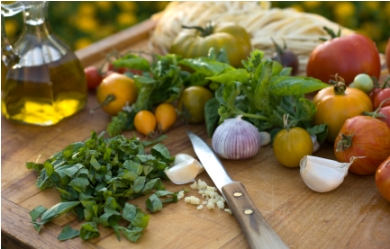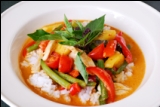Cooking with Fresh Herbs
Healthy cooking with fresh herbs adds an incredible amount of flavor to your dishes. For people watching their diet, the rich taste of fresh herbs offers the benefit of staving off some of those cravings. Additionally, if you want to decrease your salt intake, fresh herbs give you great taste without sodium making for more healthy recipes.
The Fresh Herb Equation
Nearly every chef has the mantra, "fresher is better." When it comes to fresh herbs, that’s certainly true. These spices kick up bland food and make it into something for which people ask the recipe. Additionally freshly picked herbs look beautiful on the plate and have a stronger aromatic appeal.Hint: Check your recipes. Many recipes use measures based on dry herbs. On average one tablespoon of fresh herb equates to one teaspoon of dry herb.
History
Cooking with fresh herbs has a long and luscious history. Actually, one of the most common uses for fresh herbs was as part of the ancient healer’s kit. No matter where you went in the world, the local Medicine Man or Shaman had something green and leafy to cure what ails you.Cooking with Basil
 Basil is a unique herb in that it has both sweet and savory qualities. It pairs best with onions, garlic, tomatoes, olive, orange, lemon, white wine and cheeses like mozzarella. A lovely side-effect of including basil in your dishes is that it deters flatulence, which makes it an ideal addition to those spicy blends.
Basil is a unique herb in that it has both sweet and savory qualities. It pairs best with onions, garlic, tomatoes, olive, orange, lemon, white wine and cheeses like mozzarella. A lovely side-effect of including basil in your dishes is that it deters flatulence, which makes it an ideal addition to those spicy blends.Overall you want to use the leaves of the basil plants not the stems. The stem portion has a bitter flavor that really doesn’t illustrate the signature flavor of this herb. If you grow basil at home, you can pinch it back to encourage more leaf growth but don’t toss out those flowers! They’re edible too!
In terms of other herbs that mingle with basil on a friendly basis, look to oregano, sage, rosemary, salt and pepper. Wait to add your fresh basil into a recipe until the last possible few minutes. If you don’t, you’ll loose a lot of flavor to the heat.
If you enjoy cooking with basil regularly consider infusing it into oil. Take a good handful of fresh leaves and put them into a bottle of extra virgin olive oil. Leave that in a sunny window and shake daily. After a week, test the results. If it’s not strong enough, strain out the old leaves, add fresh and repeat.
Helps and hints
Cooking with fresh herbs completes your dish in an exciting and enjoyable way. Remember to make sure that the herb is clean and free of any mold or dirt. Use the best-looking leaves – those that are bright and show no signs of withering. Taste test your herbs before adding them to a recipe as growing conditions can change the flavor dramatically. Finally reserve edible flowers from your fresh herbs and use them as garnishes.
Search Our
Family of Sites:
Translate the Page
Visit The Basil Market
For All Your Shopping Needs
Recipe Share

Use One; Add One





New! Comments
Let's hear from you! Leave me a comment in the box below.